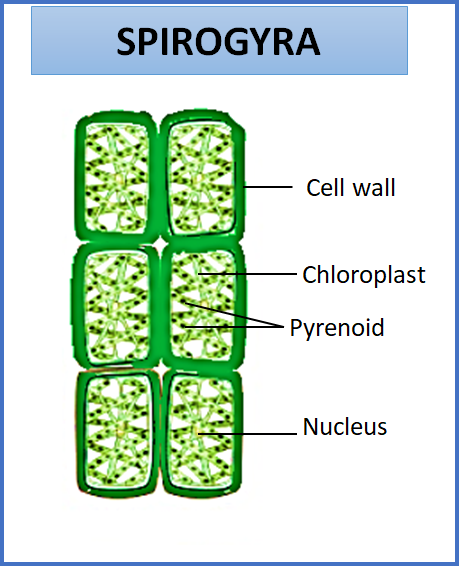
Spirogyra belongs to the class
(a) Rhodophyceae
(b) Cyanophyceae
(c) Xanthophyceae
(d) Chlorophyceae
Answer
468k+ views
Hint: They are a species of green algae, characterized primarily by ultrastructural morphology. Due to the superiority of chlorophyll a and chlorophyll b pigments, they are typically grey. Depending on the species, the chloroplast can be discoid, plate-like, reticulated, cup-shaped, spiral, or ribbon-shaped.
Complete answer:
Spirogyra is a filamentous charophyte green algae of the order Zygnematales, named for the helical or spiral structure of the chloroplasts that is characteristic of the genus. Spirogyra (common names include water silk, mermaid tresses, and blanket weed).

Spirogyra, (Spirogyra genus) , any member of the group of some 400 free-floating green algae species (Chlorophyta division) found worldwide in freshwater environments. Spirogyra are filamentous algae that consist of thin unbranched chains of cylindrical cells, named for their beautiful spiral chloroplasts. They can form masses, buoyed by oxygen bubbles released during photosynthesis, that float near the surface of streams and ponds. In laboratory demonstrations, they are widely used.
Additional information:
Rhodophyceae (Red Algae): This is a large algae group consisting of approximately 831 genera and more than 5,250 species. Because of the presence of a water-soluble red pigment, r- phycoerythrin, they are widely known as red algae.
Cyanophyceae (blue-green algae): are photosynthetic-like algal-like bacteria that can mainly contaminate the supply of surface water during the warm summer months. Microcystin, which gives the water a mouldy, musty, grassy, or septic-tank odor, is the toxic part.
A significant group of heterokont algae is the yellow-green algae or the Xanthophyceae. Many live in freshwater, but others are present in marine and terrestrial ecosystems. They range from single-celled flagellates to simple forms of colonies and filaments.
So, the correct answer is ‘(d) Chlorophyceae’.
Note: There is a large central vacuole in each cell of the filaments, inside which the nucleus is suspended by fine cytoplasm threads. The chloroplasts form a spiral around the vacuole and have specialized bodies that store starch, known as pyrenoids. The inner layer of cellulose and the outer layer of pectin, which is responsible for the algae's slippery texture, form the cell wall.
Complete answer:
Spirogyra is a filamentous charophyte green algae of the order Zygnematales, named for the helical or spiral structure of the chloroplasts that is characteristic of the genus. Spirogyra (common names include water silk, mermaid tresses, and blanket weed).

Spirogyra, (Spirogyra genus) , any member of the group of some 400 free-floating green algae species (Chlorophyta division) found worldwide in freshwater environments. Spirogyra are filamentous algae that consist of thin unbranched chains of cylindrical cells, named for their beautiful spiral chloroplasts. They can form masses, buoyed by oxygen bubbles released during photosynthesis, that float near the surface of streams and ponds. In laboratory demonstrations, they are widely used.
Additional information:
Rhodophyceae (Red Algae): This is a large algae group consisting of approximately 831 genera and more than 5,250 species. Because of the presence of a water-soluble red pigment, r- phycoerythrin, they are widely known as red algae.
Cyanophyceae (blue-green algae): are photosynthetic-like algal-like bacteria that can mainly contaminate the supply of surface water during the warm summer months. Microcystin, which gives the water a mouldy, musty, grassy, or septic-tank odor, is the toxic part.
A significant group of heterokont algae is the yellow-green algae or the Xanthophyceae. Many live in freshwater, but others are present in marine and terrestrial ecosystems. They range from single-celled flagellates to simple forms of colonies and filaments.
So, the correct answer is ‘(d) Chlorophyceae’.
Note: There is a large central vacuole in each cell of the filaments, inside which the nucleus is suspended by fine cytoplasm threads. The chloroplasts form a spiral around the vacuole and have specialized bodies that store starch, known as pyrenoids. The inner layer of cellulose and the outer layer of pectin, which is responsible for the algae's slippery texture, form the cell wall.
Recently Updated Pages
Master Class 11 Economics: Engaging Questions & Answers for Success

Master Class 11 Business Studies: Engaging Questions & Answers for Success

Master Class 11 Accountancy: Engaging Questions & Answers for Success

The correct geometry and hybridization for XeF4 are class 11 chemistry CBSE

Water softening by Clarks process uses ACalcium bicarbonate class 11 chemistry CBSE

With reference to graphite and diamond which of the class 11 chemistry CBSE

Trending doubts
What are the elders in Goa nostalgic about class 11 social science CBSE

Define least count of vernier callipers How do you class 11 physics CBSE

Write the differences between monocot plants and dicot class 11 biology CBSE

Which of the following is not a feature of the election class 11 social science CBSE

The mass of oxalic acid crystals H2C2O42H2O required class 11 chemistry CBSE

How many squares are there in a chess board A 1296 class 11 maths CBSE




